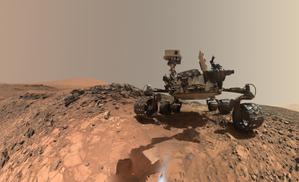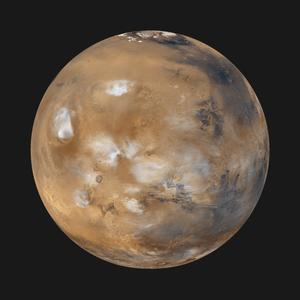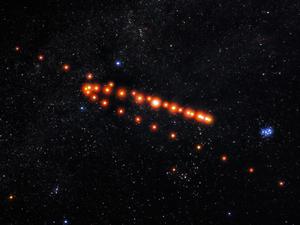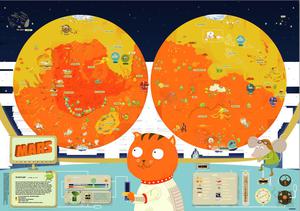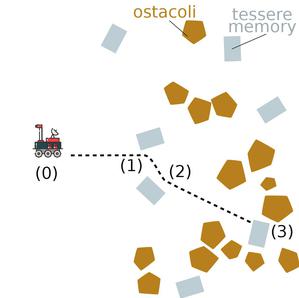Glossary term: Mars
Description: Mars est la quatrième planète du système solaire à partir du Soleil. C'est une planète tellurique rocheuse dont le rayon est d'un peu moins de 3 400 kilomètres (km), soit un peu plus de la moitié du rayon de la Terre. Mars possède une atmosphère très fine, un vaste réseau de canyons et la plus haute montagne du système solaire : un volcan éteint appelé Olympus Mons. On pense qu'elle a abrité de l'eau liquide plus tôt dans son existence.
Sa distance typique par rapport au Soleil est d'environ 228 millions de km, soit 1,52 unité astronomique (distance Terre-Soleil). Il lui faut 687 jours pour parcourir une orbite autour du Soleil. Mars possède deux petites lunes, Phobos et Deimos.
Elle porte le nom du dieu romain de la guerre. Elle est souvent appelée "planète rouge" en raison de sa couleur rougeâtre. Au fil des ans, les scientifiques ont envoyé de nombreux atterrisseurs sur Mars afin d'étudier sa composition et son atmosphère.
Related Terms:
See this term in other languages
Term and definition status: The original definition of this term in English have been approved by a research astronomer and a teacher The translation of this term and its definition is still awaiting approval
The OAE Multilingual Glossary is a project of the IAU Office of Astronomy for Education (OAE) in collaboration with the IAU Office of Astronomy Outreach (OAO). The terms and definitions were chosen, written and reviewed by a collective effort from the OAE, the OAE Centers and Nodes, the OAE National Astronomy Education Coordinators (NAECs) and other volunteers. You can find a full list of credits here. All glossary terms and their definitions are released under a Creative Commons CC BY-4.0 license and should be credited to "IAU OAE".
If you notice a factual or translation error in this glossary term or definition then please get in touch.
Related Media
Le rover martien Curiosity
Credit: NASA/JPL-Caltech/MSSS credit link
License: PD Public Domain icons
Mars
Credit: NASA/JPL/MSSS credit link
License: PD Public Domain icons
Equatorial Milky Way
Credit: Giorgia Hofer/IAU OAE
License: CC-BY-4.0 Creative Commons Attribution 4.0 International (CC BY 4.0) icons
Mouvement rétrograde de Mars
Credit: Rob Kerby Guevarra/UAI OAE (CC BY 4.0)
License: CC-BY-4.0 Creative Commons Attribution 4.0 International (CC BY 4.0) icons
Related Activities
Children's Planetary Maps: Mars
astroEDU educational activity (links to astroEDU website) Description: Explore planet Mars, learning how to use planetary maps!
License: CC-BY-4.0 Creative Commons Attribution 4.0 International (CC BY 4.0) icons
Tags:
Maps
, Planetary cartography
Age Ranges:
6-8
, 8-10
, 10-12
, 12-14
Education Level:
Middle School
, Primary
, Secondary
Areas of Learning:
Social Research
Costs:
Free
Duration:
2 hours
Group Size:
Group
Skills:
Analysing and interpreting data
, Asking questions
, Constructing explanations
Driving on Mars
astroEDU educational activity (links to astroEDU website) Description: An educational interdisciplinary game to drive a rover on Mars
License: CC-BY-4.0 Creative Commons Attribution 4.0 International (CC BY 4.0) icons
Tags:
Game
, robot
, robotics
, simulation
, telecommunications
Age Ranges:
14-16
, 16-19
Education Level:
Middle School
, Secondary
Areas of Learning:
Guided-discovery learning
Costs:
Low Cost
Duration:
2 hours
Group Size:
Group
Skills:
Communicating information
, Developing and using models
, Using mathematics and computational thinking
